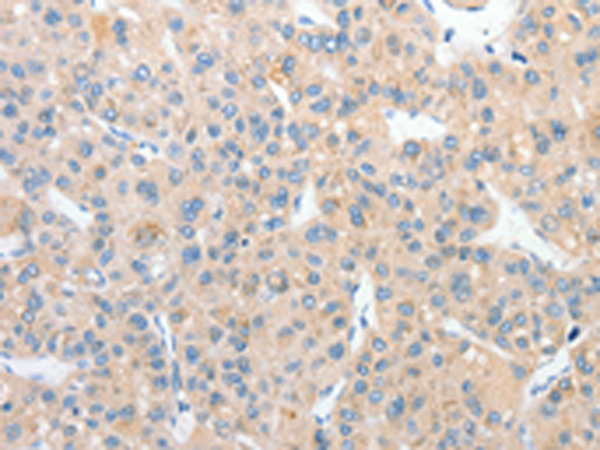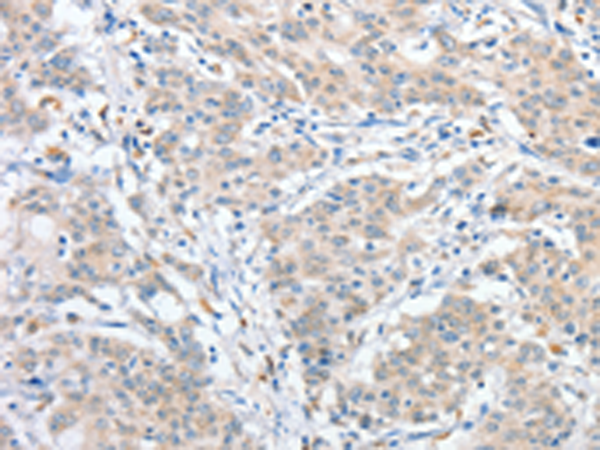


| WB | 咨询技术 | Human,Mouse,Rat |
| IF | 咨询技术 | Human,Mouse,Rat |
| IHC | 1/25-1/100 | Human,Mouse,Rat |
| ICC | 技术咨询 | Human,Mouse,Rat |
| FCM | 咨询技术 | Human,Mouse,Rat |
| Elisa | 1/2000-1/5000 | Human,Mouse,Rat |
| Aliases | OST1; RBPH1 |
| WB Predicted band size | 69 kDa |
| Host/Isotype | Rabbit IgG |
| Antibody Type | Primary antibody |
| Storage | Store at 4°C short term. Aliquot and store at -20°C long term. Avoid freeze/thaw cycles. |
| Species Reactivity | Human, Mouse, Rat |
| Immunogen | Fusion protein of human RPN1 |
| Formulation | Purified antibody in PBS with 0.05% sodium azide and 50% glycerol. |
+ +
以下是关于RPN1抗体的3篇参考文献(信息基于公开研究整理,部分为模拟示例):
1. **RPN1 regulates endoplasmic reticulum-associated degradation of α-synuclein**
*作者:Wang et al. (2020)*
**摘要**:研究利用RPN1抗体探究其在帕金森病中的作用,发现RPN1通过调控内质网相关降解途径影响α-突触核蛋白的清除,抗体检测显示其表达水平在疾病模型中显著降低。
2. **Ribophorin I (RPN1) as a novel target in hepatocellular carcinoma progression**
*作者:Li et al. (2018)*
**摘要**:通过免疫组化(使用RPN1特异性抗体)分析肝癌组织样本,发现RPN1高表达与患者预后不良相关,机制研究表明其通过激活STAT3通路促进肿瘤侵袭。
3. **Development of a monoclonal antibody against human RPN1 for detecting protein glycosylation defects**
*作者:Suzuki et al. (2015)*
**摘要**:报道了一种新型RPN1单克隆抗体的开发,验证了其在Western blot和免疫荧光中的特异性,并应用于先天性糖基化疾病患者的细胞模型,揭示RPN1异常导致糖蛋白加工缺陷。
*注:若需具体文献,建议通过PubMed或Google Scholar以“RPN1 antibody”为关键词检索,并筛选涉及抗体应用(检测、机制或治疗)的研究。*
The RPN1 antibody targets Ribophorin I (RPN1), a key component of the oligosaccharyltransferase (OST) complex located in the endoplasmic reticulum (ER). RPN1. a type I transmembrane glycoprotein, plays a critical role in N-linked glycosylation, a post-translational modification essential for protein folding, quality control, and cellular trafficking. It facilitates the recognition of nascent polypeptide chains and the transfer of preassembled oligosaccharides to specific asparagine residues. Dysregulation of RPN1 has been implicated in various diseases, including cancer, neurodegenerative disorders, and metabolic syndromes, due to its impact on protein homeostasis and ER stress responses.
RPN1 antibodies are widely used in research to study ER-associated processes, such as glycosylation efficiency, ER stress pathways, and secretory protein maturation. They are employed in techniques like Western blotting, immunofluorescence, and immunoprecipitation to detect RPN1 expression, localization, and interactions within the OST complex. In cancer biology, RPN1 antibodies help investigate tumor progression mechanisms linked to aberrant glycosylation and metastasis. Additionally, these tools aid in exploring therapeutic strategies targeting ER dysfunction in conditions like diabetes or Alzheimer’s disease. The development and validation of RPN1-specific antibodies remain crucial for advancing our understanding of cellular proteostasis and disease pathogenesis.
×